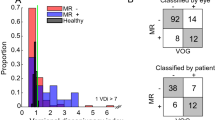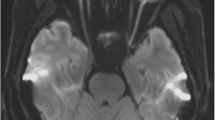Abstract
Purpose
The purpose of this study was to investigate the diagnostic efficacy of a range of conventional magnetic resonance imaging (MRI) pulse sequences in the identification of internuclear ophthalmoplegia (INO) caused by medial longitudinal fasciculus (MLF) lesions in multiple sclerosis patients using a receiver-operating characteristic (ROC) methodology.
Methods
A total of 15 clinically confirmed INO and 15 control subjects underwent conventional MRI at 1.5 T consisting of T2-weighted, proton density (PD)-weighted, and fluid-attenuated inversion recovery (FLAIR) sequences, following full institutional approval. A free-response, multiple-reader multiple-case design ROC study was used to evaluate the diagnostic efficacy of each sequence. All imaging sequences were evaluated by 10 board-certified neuroradiologists. Area under the curve (AUC), sensitivity, and specificity were analysed statistically for all three pulse sequences using repeated-measures analyses of variance and post-test analysis using Bonferroni’s multiple comparison test of differences.
Results
No significant AUC differences were found between the three sequences (p = 0.0697), with T2 recording the highest AUC (0.8346). Sensitivity differences between PD (0.7927) and FLAIR (0.6329) were significant (p < 0.05). Non-significant differences were also evident between T2 and FLAIR (p = 0.0511). The specificity analysis revealed an overall difference (p = 0.0005), with specific inter-sequence differences shown between T2 and PD (p < 0.05) and PD and FLAIR (p < 0.001) with the PD values being lower than those provided with the other two sequences.
Conclusion
T2-weighted axial imaging through the MLF region resulted in the greatest overall diagnostic efficacy when viewing a combination of mean AUC, sensitivity, and specificity, in terms of the identification of INO-causing lesions.

Similar content being viewed by others
References
Matthews B. Symptoms and signs of multiple sclerosis. In: Compston A, Ebers G, Lassmann H, McDonald I, Matthews B, Wekerle H, editors. McAlpine’s multiple sclerosis. 3rd ed. London: Churchill Liveingstone; 1998. pp. 157–62.
Poser CM, Brinar VV. Diagnostic criteria for multiple sclerosis. Clin Neurol Neurosurg. 2001;103:1–11.
Polman CH, Reingold SC, Banwell B, Clanet M, Cohen JA, Filippi M, et al. Diagnostic criteria for multiple sclerosis: 2010 revisions to the McDonald criteria. Ann Neurol. 2011;69(2):292–302.
Frohman EM, Goodin DS, Calabresi PA, Corboy JR, Coyle PK, Filippi M, et al. The utility of MRI in suspected MS: report of the Therapeutics and Technology Assessment Subcommittee of the American Academy of Neurology. Neurology. 2003;61:602–11.
Leigh RJ, Wolinsky JS. Keeping an eye on MS. Neurology. 2001;57:751–2.
Comi G, Filippi M, Barkhof F, Durelli L, Edan G, Fernández O, et al. Effect of early interferon treatment on conversion to definite multiple sclerosis. Lancet. 2001;357:1576–82.
Miller DH, Grossmann RI, Reingold SC, McFarland HF. The role of magnetic resonance techniques in understanding and managing multiple sclerosis. Brain. 1998;121:3–24.
Pelidou SH, Giannopoulos S, Tzavidid S, Lagos G, Kyritsis AP. Multiple sclerosis presented as clinically isolated syndrome: the need for early diagnosis and treatment. Ther Clin Risk Manag. 2008;4(3):627–30.
Frohman EM, Zhang H, Kramer PD, Fleckenstein J, Hawker K, Racke MK, et al. MRI characteristics of the MLF in MS patients with chronic internuclear ophthalmoparesis. Neurology. 2001;57:762–8.
Miller D, Barkhof F, Montalban X, Thompson A, Filippi M. Clinically isolated syndrome suggestive of multiple sclerosis, part I: natural history, pathogenesis, diagnosis, and prognosis. Lancet Neurol. 2005;4:281–8.
Muri RM, Meienberg O. The clinical spectrum of internuclear ophthalmoplegia in multiple sclerosis. Arch Neurol. 1985;42:851–5.
Savino PJ. Neuro-ophthalmology. In: Tasman W, Jaeger EA, editors. The Wills Eye Hospital atlas of clinical ophthalmology. 1st ed. Philadelphia: Lippincott-Raven; 1996. pp. 310–1.
Lavin PJM, Donahue SP. Disorders of supranuclear control of ocular motility. In: Yanoff M, Duker JS, editors. Ophthalmology. 2nd ed. St. Louis: Mosby; 2004. p. 1310.
Atlas SW, Grossman RI, Savino PJ, Schatz NJ, Sergott RC, Bosley TM, et al. Internuclear ophthalmoplegia: MR-anatomic correlation. AJNR Am J Neuroradiol. 1987;8:243–7.
Barnes D, McDonald WI. The ocular manifestations of multiple sclerosis. 2. Abnormalities of eye movements. J Neurol Neurosurg Psychiatry. 1992;55(10):863–8.
Marx JJ, Thoemke F, Fitzek S, Vucurevic G, Fitzek C, Mika-Gruettner A, et al. A new method to investigate brain stem structural–functional correlations using digital post-processing MRI—reliability in ischemic internuclear ophthalmology. Eur J Neurol. 2001;8:489–93.
Flipse JP, Straathof CSM, Van der Steen J, Van Leeuwen AF, Van Doorn PA, Van der Meché, et al. Binocular saccadic eye movements in multiple sclerosis. J Neurol Sci. 1997;148:53–65.
Frohman EM, Frohman TC, O’Suilleabhain P, Zhang H, Hawker K, Racke M, et al. Quantitative oculographic characterization of internuclear ophthalmoparesis in multiple sclerosis: the versional dysconjugacy index Z score. J Neurol Neurosurg Psychiatry. 2002;73:51–5.
Ventre J, Vighetto A, Bailly G, Prablanc C. Saccade metrics in multiple sclerosis: versional velocity disconjugacy as the best clue? J Neurol Sci. 1991;102:144–9.
Alexander JA, Castillo M, Hoffman JC. Magnetic resonance findings in a patient with internuclear ophthalmoplegia. J Clin Neuroophthalmol. 1991;11:58–61.
Balanos I, Lozano D, Cantú C. Internuclear ophthalmoplegia: causes and long-term follow-up in 65 patients. Acta Neurol Scand. 2004;110:161–5.
De Seze J, Lucas C, Leclerc X, Sahli A, Vermersch P, Leys D. One-and-a-half syndrome in pontine infarcts: MRI correlates. Neuroradiology. 1999;41:666–9.
Eggenberger E, Golnik K, Lee A, Santos R, Suntay A, Satana B, et al. Prognosis of ischaemic internuclear ophthalmoplegia. Ophthalmology. 2002;109:1676–8.
Korteweg T, Tintoré M, Uitdehaag B, Rovira A, Frederiksen J, Miller D, et al. MRI criteria for dissemination in space in patients with clinically isolated syndromes: a multicentre follow-up study. Lancet Neurol. 2006;5:221–7.
Simon JH, Li D, Traboulsee A, Coyle PK, Arnold DL, Barkhof F, et al. Standardized MR imaging protocol for multiple sclerosis: consortium of MS centers consensus guidelines. AJNR Am J Neuroradiol. 2006;27:455–61.
The Consortium of Multiple Sclerosis Centers. Consortium of MS centres MRI protocol for the diagnosis and follow-up of MS. 2009 revised guidelines. 2009. http://c.ymcdn.com/sites/www.mscare.org/resource/collection/9C5F19B9-3489-48B0-A54B-623A1ECEE07B/mriprotocol2009.pdf.
Filippi M, Yousry T, Baratti C, Horsfield MA, Mammi S, Becker C, et al. Quantitative assessment of MRI lesion load in multiple sclerosis. A comparison of conventional spin-echo with fast fluid attenuation inversion recovery. Brain. 1996;119:1349–55.
Yousry TA, Filippi M, Becker C, Horsfield MA, Voltz R. Comparison of MR pulse sequences in the detection of multiple sclerosis lesions. AJNR Am J Neuroradiol. 1997;18:959–63.
Pikus L, Woo JH, Wolf RL, Herskovits EH, Moonis G, Jawad AF, et al. Artificial multiple sclerosis lesions on simulated FLAIR brain MR images: echo time and observer performance in detection. Radiology. 2006;239:238–45.
Woo JH, Henry LP, Krejza J, Melhem ER. Detection of simulated multiple sclerosis lesions on T2-weighted and FLAIR images of the brain: observer performance. Radiology. 2006;241:206–12.
Wattjes MP, Lutterbey GG, Harzheim M, Gieseke J, Traber F, Klotz L, et al. Imaging of inflammatory lesions at 3.0 Tesla in patients with clinically isolated syndromes suggestive of multiple sclerosis: a comparison of fluid-attenuated inversion recovery with T2 turbo spin-echo. Eur Radiol. 2006;16:1494–500.
Metz CE. Receiver operating characteristic analysis: a tool for the quantitative evaluation of observer performance and imaging systems. J Am Coll Radiol. 2006;3:413–22.
Stevenson VL, Parker GJM, Barker GJ, Birnie K, Tofts PS, Miller DH, et al. Variations in T1 and T2 relaxation times of normal appearing white matter and lesions in multiple sclerosis. J Neurol Sci. 2000;178:81–7.
Simon B, Schmidt S, Lukas C, Gieseke J, Traber F, Knol DL, et al. Improved in vivo detection of cortical lesions in multiple sclerosis using double inversion recovery MR imaging at 3 Tesla. Eur Radiol. 2010;20:1675–83.
Acknowledgements
We express our thanks and gratitude to the staff and examiners from the American Board of Radiology for their assistance and participation in this study. We would also like to thank Dr. Mark McEntee (University of Sydney) and Dr. Rachel Toomey (University College Dublin) for their help with data acquisition and data analysis.
Conflict of Interest
The authors have no conflict of interest related to the present study.
Author information
Authors and Affiliations
Corresponding author
Rights and permissions
About this article
Cite this article
McNulty, J., Lonergan, R., Brennan, P. et al. Diagnostic Efficacy of Conventional MRI Pulse Sequences in the Detection of Lesions Causing Internuclear Ophthalmoplegia in Multiple Sclerosis Patients. Clin Neuroradiol 25, 233–239 (2015). https://doi.org/10.1007/s00062-014-0295-5
Received:
Accepted:
Published:
Issue Date:
DOI: https://doi.org/10.1007/s00062-014-0295-5




